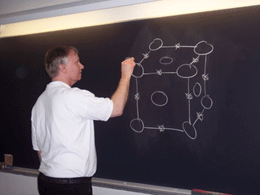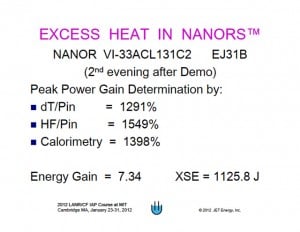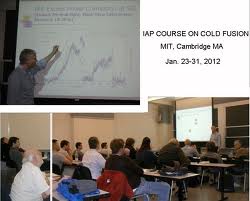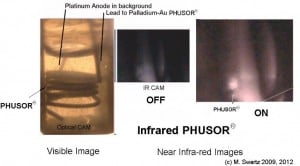 The following is a further posting in a series of articles by David French, a patent attorney with 35 years experience, which will review patents of interest and other matters touching on the field of Cold Fusion.
The following is a further posting in a series of articles by David French, a patent attorney with 35 years experience, which will review patents of interest and other matters touching on the field of Cold Fusion.
This is a report of the technology presented at ICCF-17 but released in the spring of 2012 following demonstrations held at MIT over January 30-31, 2012. I personally attended those demonstrations and can confirm that the graphic outputs referenced below and in the ICCF-17 presentation of Dr Peter Hagelstein were in fact generated on that occasion. This may be the technology that demonstrates Cold Fusion in a way that can be observed by anyone around the world.
Breaking the Dam of Disbelief
The year 2013 will be the year in which the dam of disbelief respecting the Fleischmann & Pons phenomena will finally break. This will start with the recent successful showing of the film “The Believers” in Chicago on October 16 and its follow-up presentations. The press will gradually notice the issue. Enough courageous journalists will demand from their editors page-space to expose the shabby treatment of this phenomenon that has occurred over the past 22 years.
Sufficient demonstrations of unexplained excess energy have been repeated in laboratories around the world to shatter the paradigm that Cold Fusion is a pathological science. The result will be a demand for experiments that can be reliably duplicated by persons, agencies, laboratories and businesses around the world interested in re-examining this New Energy Effect.
Need for a Commercially Vendible demonstration of Cold Fusion
An opportunity exists to sell and distribute widely electronic data acquisition and presentation equipment in conjunction with a practical set-up that demonstrates Cold Fusion. Such an arrangement should:
• not rely on the presence of pressurized hydrogen or electrolyte fluids
• operate at moderate temperatures
• provide ready access to the reactor center for easy experimentation
• allow ready substitution of reactive elements for repair and alternate testing procedures
• impose minimum power requirements
• clearly demonstrate a Cold Fusion/LENR effect
• allow a variety of experiments to be conducted by users.
All of these experiments should both serve to demonstrate the Cold Fusion effect and allow researchers to better understand and advance the exploitation of this phenomenon
Opportunity presented by the JET Energy Inc’s “Nanor”
JET Energy Inc. is a company established just outside Boston, Massachusetts by Dr Mitchell Swartz. Mitchell Swartz was one of the original experimenters in the field of Cold Fusion; he became involved directly after the Fleischmann & Pons effect was demonstrated in 1989. Mitchell Swartz has been working with Dr Peter Hagelstein, a professor at MIT and one of the eminent theoreticians in this field. The following information is taken from a paper presented by Dr Peter Hagelstein on behalf of Dr Mitchell Swartz and Jet Energy Inc at ICCF-17. The paper for this presentation will form part of the final report of the ICCF-17 proceedings.
The reactor
JET Energy has developed a demonstration Cold Fusion reactor that relies on a simple core element that is essentially the size of an ohmic resistor. This “Nanor” ™ contains nanostructured pellets of Palladium embedded in zirconium oxide insulation that are pre-loaded with high pressure deuterium and sealed into a small cylinder with electrical connections at the respective ends. The similarity in outward appearance to an ohmic resistor is exact.
For purposes of demonstrating the Cold Fusion effect and quantifying the excess heat being generated, this small cylindrical element, the “NANOR™”, is utilized in conjunction with a “control resistor” bonded along side. The bonding agent is a thermally conductive but electrically insulative glue. Both elements provide easily accessible independent electrical leads at their respective ends.
These components are contained in a thermally isolated environment. Optionally the assembly can be placed inside a traditional calorimeter, but this is not essential. Temperature sensors are bonded to the system which, in conjunction with the control resistor can function equivalently to a calorimeter.
To achieve a Cold Fusion/New Energy effect Dr Swartz passes a low-level current through the Nanor, e.g. 10 milliwatts. Perhaps there are other features included in the control circuit and wave form applied. Whatever special tricks are used, the result is to produce more than a minimal amount of excess energy that conclusively demonstrates this new energy effect. To quantify the results, the following arrangement is employed.
Before activating the Nanor, a small current is first passed through the control resistor adjacent to the Nanor. Due to the ohmic resistance in the control resistor the temperature in this resistor, along with that of the Nanor which is glued close by, rises by a small amount, e.g. 1-2 Centigrade degrees. The amount of current and voltage across the resistor are noted, giving the amount of power needed to create this rise in temperature. After the temperature rise generated by the control resistor has relaxed to its starting value, power is applied in turn to the Nanor.
Sufficient current is fed through the Nanor to produce an approximate rise in temperature equivalent to that just achieved in the control resistor. Remarkably, far less power need be applied to the Nanor to achieve this effect, i.e. less power is required to reach a similar temperature to that established using the control resistor. Put alternately, when comparable energies are applied to the Nanor, a greater temperature rise occurs in the Nanor than occurs in the control resistor. These experiments demonstrate the unequivocal generation of unexplained excess energy.
The display
The power circuitry incorporates a control system that alternates between first heating the control resistor with a known amount of electrical power and then applying a lower level of electrical power to the Nanor. The temperature rise generated first in the control resistor and then in the Nanor as detected by the temperature sensor is shown graphically on the screen of a computer. Using this arrangement the Nanor has demonstrated gains on the order of 800 to 1600%, i.e. a coefficient of performance – COP of 8-16. The graphic display showing this effect can be seen here.
The gain is represented by the ratio of the respective heights for the normalized temperature of the Nanor, indicated by “delta-T/pin” curve, with respect the height of the stepped trace for “input power”, both on the right-side of the display. Here, it is important to note that “normalizing” the delta-T (dividing the measured delta-T by the measured applied power) has the effect of removing the step-like response of the delta-T to the step-like application of input power, resulting in a “flat” response of the control resistor, and a “flatter” response of the NANOR. Note that this normalized gain falls off somewhat with increasing power for the Nanor.
From the graph it is demonstrated that providing lower power to the Nanor will achieve the same temperature excursion as that demonstrated by the control resistor using higher power. While the effect is not being monitored at a constant temperature, the temperature excursions are very small, e.g. 1-2 centigrade degrees. Therefore results nearly equivalent to having a complex constant-temperature calorimeter are achieved. Essentially, the energy output of the Nanor is inferred by comparing the temperature change achieved to that produced by the control resistor. With the high COP’s being achieved, the result is unmistakable.
The temperature rise of the Nanor-control resistor combination is conveniently presented on a computer display in which the temperature traces are arranged graphically directly following each other. The cycle is carried-out repeatedly, with a relaxation delay in between, to provide interlaced graphic demonstrations of the generation of unexplained excess heat next to a calibration curve. As this effect continues for many days, the only possible conclusion is that the excess energy is arising from some form of nuclear effect. Hence this apparatus demonstrates the reality of “Cold Fusion” or some nuclear process the mechanism of which is not yet conclusively established.
Stepped power increases
In order to produce more information in the computer display, the electrical circuitry supporting the demonstration applies power to both the control resistor and the Nanor in steps of regularly increasing applied power. Each time the power rises by a step, the temperature of the system rises by a related step. The correlation is not precisely even. Further this feature demonstrates that the Nanor exhibits differing gains when driven at different power levels. Importantly, the Nanor can be over-driven, providing a COP which is reduced from the maximum possible once the optimum power input is exceeded. This is readily apparent from the display.
Packaging the kit
The Nanor demonstration apparatus is very compact. The Nanor and control resistor pair would, by themselves, fit in a very small insulated box if the decision were made to dispense with the standard surrounding calorimeter apparatus. A surrounding calorimeter apparatus could be employed as a back-up to demonstrate that, over time, you can measure the accumulating excess heat that is being generated. In fact, only a small insulated box is required if it is accepted that the temperature excursion demonstrated by the control resistor can serve to calibrate the amount of heat envolving when the Nanor is operating.
Dispensing with the traditional calorimeter allows the reactor box to be hardly larger than a package of cigarettes. Coupled to the wires leading out of this box are a power supply and a data acquisition device. The data acquisition device provides an output that generates the display on the screen of a personal computer. The device so presented would fit, together with its data acquisition device and cables for linking to a PC, into a standard briefcase. Indeed, the briefcase could also include the PC since there would be enough room to fit it in!
Since the reactor can be contained in a relatively small volume it would be easily accessible to install substitute replacements or alternate arrangements which are instrumented according to the desires of a researcher. By providing pre-instrumented variations in the Nanor a variety of experiments could be carrying my users. In every case, the object would be to determine the ways in which it is possible to modulate the Cold Fusion effect. Anyone purchasing the kit would have the advantage of a quick-learning tool to get up-to-speed on the principles of this new and extremely important phenomenon. Universities could buy multiple units for their undergraduate students.
Possible experiments
Some of the experiments that could be conducted include:
• varying the applied DC field to determine the effect on gain or COP. This means identifying the “sweet spot”, also known as the “Optimal Operating Point”
• varying the “relaxation” time between initiating a repetition of excess heat events to determine the effect
• carrying-out the various processes at differing ambient temperatures for the Nanor
• applying an AC component of varying frequencies and strength to the applied DC field
• encircling the Nanor with an insulated wire and applying a co-axial magnetic field while carrying-out the repertoire of other manipulations
• placing a pair of collateral electrostatic plate electrodes on either side of the Nanor and applying varying electrostatic fields, both DC and AC to determine the effect on the excess heat event
• attaching ultrasound transducers to the side of the Nanor to determine the effect of ultrasound on the excess heat effect
• carrying-out experiments with the Nanor having various levels of loading
• carrying out the experiments with twin or triple Nanors surrounding the control resistor, each instrumented with temperature sensors to establish the relative consistency of behavior of the respective Nanors.
Opportunity for Commercialization
JET Energy’s Nanor represents a demonstrated, operational system for researchers to explore the Cold Fusion effect. It is ideally adapted to being integrated into a unit suitable for sale to universities and laboratories, indeed to high schools, as a demonstration device confirming the existence of the Cold Fusion/LENR/New Energy Effect phenomena. Indeed, this demonstration can operate with a normal home PC on the kitchen table top.
This is an ideal system for introducing this new science to the world. JET Energy Inc. is presently working to improve the Nanor and develop a vendible package. Who is going to be the first to step forward and boost JET Energy’s innovation to the forefront of the coming wave of commercial applications that will rely on this wonderful new discovery for humanity?











